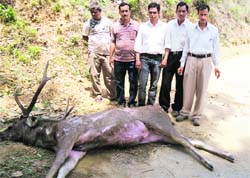These days we rarely want to convert data back
and forth between EBCDIC and ASCII. What dd means
for us is not anymore a
joke on JCL,
rather Dump Data (in particular, Dump
Disks) -- and we would like to be enabled to do it
in a robust way.
Unfortunately, as it shockingly dawned on me upon
trying to migrate my data off of an errant disk,
dd falls short of this. It either gives up on
facing a read error, or keeps going on nonchalantly,
screwing up offsets (ie. after an unreadable region
of one megabytes, the consequential data will be
shifted one megabyte backwards on the target media,
instead of leaving a one megabyte hole).
So then, in order:
- I cobbled together this program
- I successfully applied it to migrate over my data (call unit test)
- I read after [dd on Wikipedia](http://en.wikipedia.org/wiki/Dd_(Unix\))
upon which I realized that there is a bunch of post-
ddattempts born out of the very same frustration.
So I could have applied any of these very fine tools... at this point I would be happy if I could say that this program took less time to put together than look after prior art on Wikipedia, but that's not true. Nevertheless, almost true!
deadis dead simple small and stupid, does not try to be clever like those tools (I believe you are better at it, so I don't try to compete with you)deadcontinues in presence of errors, leaving an appropriately sized hole in the target media and a log messagedeadmakes use of the Linux sendfile(2) system call (which has been rewritten to use the splice backend as of 2.6.23), and that makes it fast by direct end-to-end in-kernel data copy.I bet aforementioned utils are too old farty to do this, although I haven't checked. Well actuallydd_rescuesupports splice(2), but that's a rather contrived construct enforcing a sandwich of pipe in between two splices,splice(2)needing to have a pipe as one end.
Note that the the sendfile(2) manpage claims that sendfile() also
demands a socket end pre-2.6.33 (most likely in reference to
v2.6.33-rc1379^271),
however dead works just fine for me on (vanillish) 2.6.32.
$ make dead
$ ./dead -h
dead does what dd(1) eventually aspired to do...
Usage: dead [-opt=val...] [--] [progressbar helper...] < infile > outfile
Data is transferred from infile to outfile using
Linux sendfile(2) (yeh, so it's Linux only).
Options (with values taking case insensitive k,m,g postfixes):
-size=N transfer N bytes (default: size of infile)
-blksize=N blocksize (default: 4194304)
-offset=N start transfer at offset N (default: 0)
-targetoffset=N position target file to N (default:
same as offset)
-logfile=F (default: stderr)
If progressbar helper utility is given, it will
be spawned and fed with data describing the
progress of the operation.
This should be almost clear, with logfile and progressbar worth for some words.
You are suggested to specify a logfile, that will have a record of all intervals where error occurred. Now those intervals still might have some useful data, which does not get transferred due to the coarse blocksize. So then you should check your disk's blocksize (
hdparm -I /dev/<disk> | grep -i 'phys.*sector'
) and re-run dead on the reported intervals (making use of
-offset and -size options) with -blksize set to the disk's
blocksize. Then you are covered.
As of progressbar, dead does not implement it, rather outsources.
Some progressbar script is provided (sambar.rb) that can be specified
as the progressbar helper argument and that will produce you a simple
progress bar; however, you can write a better one. The progress feed
consists of 64 bit signed integers; the very first one specifies the
size of the whole data to be transferred, and the consecutive ones tell
the number of bytes transferred up to that point. In case of error
dead sends a negated value so that the progress bar can mark errors.
